Communication Strategies
for People With Hearing Loss
 Taillefer Ambassador of Lobe clinics and hearing health
Marie-Josée
Taillefer Ambassador of Lobe clinics and hearing health
Marie-Josée
© Lobe Guide 2024 / © Lobe Publications 2024
loved ones 1 I speak in the same room as the person with hearing loss. 2 I get my partner's attention before talking to them (say their name, touch their shoulder, etc.). 3 I move closer and talk to my partner face to face to help them lip read. 4 I speak clearly and naturally, in a normal voice. 5 I avoid yelling. 6 I say thing differently if my partner doesn't understand well. 7 I eliminate background noise (television, radio, etc.). 8 I use natural gestures and avoid hiding my lips. 9 I advise my partner when there is an abrupt change in topic. 10 I ask questions.
Tips
Hearing Loss 1 I wear my hearing aids. 2 I say that I don't understand well. 3 I talk to my partner face to face and observe lip movements. 4 I eliminate background noise (television radio, dishwasher, music). 5 I make sure there is good lighting on my partner's face. 6 I ask about the subject we are talking about. 7 During a conference, I ask people to control turns to speak. 8 I ask not to speak too quickly. 9 I ask questions. Table of Contents 04 Communication With Friends and Family 06 Family Dinner 07 Outdoor Activities 08 Watching Television 09 In the Car 10 At the Restaurant 13 Waiting Room 14 At the Doctor 15 At the Dentist 16 Conferences in Public Places 17 Theatre 18 Home Phone 20 Assistive Listening Devices 21 Calling and Texting 9-1-1 22 Hearing Health and Communication Professionals 23 Lobe Magazine For more information about the communication strategies or for a digital version, please visit lobe.ca. .ca Merci ! To Judith Massé, MPA, audiologist, for her valuable contribution to Communication Strategies for People with Hearing Loss. © Lobe Guide 2024 / © Lobe Publications 2024
Advice to
Listening and Communication Strategies
for People With
Adapt and Improve Communication!
The idea behind the Communication Strategies Guide for People With Hearing Loss project originated in 2013 with Mr. Ronald Choquette, audiologist and associate professor of practical training in audiology at the Université de Montréal. As part of a supervised master's project, Mr. Choquette offered the opportunity to create a repertoire of communication strategies applied to listening situations identified as being more difficult for people with hearing loss. General communication strategies are frequently proposed to patients during audiology consultations, but very little material existed at the time for specific listening situations.
This guide presents the most common listening situations, as well as numerous communication strategies adapted to each situation. For each situation, a section is also dedicated to the person with whom the hard-of-hearing person is communicating, since it's always important to bear in mind that communication involves more than one person. This is one of the advantages of this guide, which provides invaluable advice to those around the person with hearing loss so that they can be properly supported.
As you read through each of the different sections, you'll see that some strategies will work for you and others won't. Remember what works for you, and reject what doesn't. This is a help for you. If certain strategies help you and you hadn't thought of them before, the objective has been achieved!
I hope you enjoy reading this book and, above all more harmonious conversations every day.
Judith Massé Audiologist
Reconnect With the Pleasure of Understanding!
If you're holding this guide in your hands, it's because you've chosen to take care of your hearing health. What a good decision, one that will enable you to maintain an active lifestyle and enjoy the company of your loved ones!
Inside this guide, you'll discover a host of tips to help you limit the impact of your hearing loss. Many of the tips are also aimed at those close to you, enabling them to take simple steps to make it easier for you to understand.
I'm well aware of the impact of hearing loss, and I know that applying the techniques developed by hearing health professionals will benefit you.
Thanks to all these strategies, you're sure to rediscover the joy of hearing and understanding!
Happy reading!
Marie-Josée Taillefer
Ambassador of Lobe clinics and hearing health

© Lobe Guide 2024 / © Lobe Publications 2024


Communication at Home
Modern houses are not all adapted to the specific needs of people with hearing loss. Three important factors can influence your understanding at home:


Lighting
Furniture arrangement
Surrounding noise
04 © Lobe Guide 2024 / © Lobe Publications 2024
For the person with hearing loss
Lighting
• Choose lamps that light the entire face.
- Install ceiling lights instead of conventional lamps at eye level.
- Favour tall and floor lamps (torchieres).
• Favour natural light.
• Sit with your back to the window so the light falls on your conversation partner’s face.
• Have multiple people with hearing loss sit in chairs facing one another so the light comes from the side.
Furniture arrangement
• Make sure armchairs and chairs are positioned no further than 6 feet apart.
• Place chairs so everyone can see each other’s faces.
• Avoid taking conversations from one room to another (or one floor to another). Ask your partner to come into the same room as you.
Surrounding noise
• Close doors of rooms where there is noise.
• Turn off or turn down televisions, radios and stereo systems.
• Use loud appliances at night (washing machine, dishwasher, etc.).
• If traffic or outdoor noise is a problem, close the windows or doors, or move to a quieter room in the house.

For conversation partners
• Get your partner’s attention before talking to them (e.g., say their name, touch their shoulder).
• Move closer to the person with hearing loss (avoid talking to them from another room or floor).
• Talk clearly and naturally, in a normal voice.
• Talk to your partner face to face to help them lip read and see your facial expressions.
• Eliminate background noise before talking to the person. For example, turn off or turn down the television or radio.
• Pay attention to lighting, so people with hearing loss can easily see your face.
• Say things differently if people with hearing loss do not understand well (by changing words or sentences, adding a gesture).
• Advise people with hearing loss when there is an abrupt change in topic or when the conversation is suddenly interrupted.
• Write down important information. In addition to the tips above, as a person with a hearing loss, you can use other strategies.
• If you have hearing aids, use them.
• When someone speaks to you, pay attention. Stop what you're doing and look at them.
• Ask the person you're talking to:
- to look at you when they speak (to observe their lip movements and facial expressions);
- to tell you the general topic;
- to speak more slowly, a little louder and without shouting;
- to say things differently and write down important information.
© Lobe Guide 2024 / © Lobe Publications 2024 05
Family Dinner
For the person with hearing loss
• Adopt a relaxed and positive attitude. Being tired and stressed will negatively affect your understanding.
• See the dinner as a time for conversation with people near you at the table.
• Advise the people you talk to that you have a hearing problem or remind them gently.
• Tell others if you think you’ll have more trouble following the conversation, e.g., “I’m tired today, so it’s harder for me to follow” or “It’s noisy here. I’m sorry, but I will have to ask you to repeat frequently.”
• If you have hearing aids, use them.
• Reduce the noise as much as you can or ask the host to do it. For example, turn off the radio, television or sound system, or turn them down. Close doors and windows.

• Verify your understanding during the conversation, e.g., “So, if I understood correctly…” or “You are talking about…”
• If the lighting seems inadequate to see your partners’ faces well, turn it up or ask your host to do it.
• Ask people to talk one at a time.
• Pick the right seat at the table.
- Sit where you can see your partners’ faces.
- Sit near the people you will be talking to the most.
- If you hear better with one ear than the other, sit with your “good” ear facing the person you will be talking to the most.
- Find the people speaking and look at them.
• Ask someone you feel comfortable with to repeat the information you did not understand or to help you follow the conversation.
• Ask others to look at you and not to cover their lips when they are talking.
• Break into subgroups of 2–3 people for discussions and change groups when needed.
• Ask specific questions. For example, instead of asking “What’s new?” say “How is work, how are your kids, how is home?”
• At the end of the meal, ask one person to stay so you can talk and ask them to repeat important information (e.g., date of the next family gathering).
• Ask to be advised when there is a sudden change in the topic of conversation.
For conversation partners
• Make sure to have the attention of people with hearing loss before talking to them.
• Look at them when you talk so they can read your lips.
• If you see that people with hearing loss have not understood a message.
- Repeat it once as you said it initially.
- If the person still does not understand, reformulate it.
- Ask the person what part of the message they did not understand well.
06 © Lobe Guide 2024 / © Lobe Publications 2024
Outdoor Activities
For the person with hearing loss
• When someone talks to you, stop what you're doing and look at them.
• Position yourself in order to avoid being dazzled by the sun shining directly in your face.
• If there is noise around you, try to move away from it. For example, if your neighbour is mowing the lawn near you.
• If you have hearing aids, use them.
If you didn't quite understand…
• Ask your partner:
- to tell you the general subject;
- to speak more slowl;
- to speak a little more loudly;
- to say things in another way.
• Summarize what you understood so your partner knows which part of the message to repeat.
For conversation partners
• Get your partner’s attention before talking to them (e.g., say their name, touch their shoulder).
• Move closer to your partner before speaking to them.
• Ensure the distance between you and them is no greater than 6 feet.
• Talk to your partner face to face to help them lip read.
• Talk a little more slowly and loudly.
• Use short sentences and simple words.
Did you know?
Wind noise through your hearing aids can make speech harder to understand and listening less enjoyable. Some hearing aids have a special function to attenuate wind noise. This helps you understand speech and makes wearing hearing aids more comfortable.
For more information, consult your audioprosthetist.

• If your partner does not understand your message, repeat it once. If they still don’t understand, reword it.
• If the person cannot understand, schedule another time to continue the conversation.
• Send a text message, if needed.


07 © Lobe Guide 2024 / © Lobe Publications 2024
Watching Television
For the person with hearing loss
• Activate the subtitle option of your television.
- For instructions, check the television user’s guide or contact your cable operator (e.g., Videotron, Bell).
- Note that when you watch a TV show translated into English from a foreign language and use subtitles in English, the actors’ lip movements will be off.
• Place your television in a closed and quiet room.
• If the sound quality of your flat screen television is poor, use external speakers.
• Place your armchair facing the television, near the speakers, and at a comfortable visual distance.
• If you hear better with one ear than the other, sit with your “good” ear towards the speaker.
• Place the television so that natural light will not reflect on the screen.
• Reduce or eliminate sources of noise or distraction when watching television, e.g., avoid using your dishwasher or the range hood during your favourite TV show.
• Use a listening system for television.
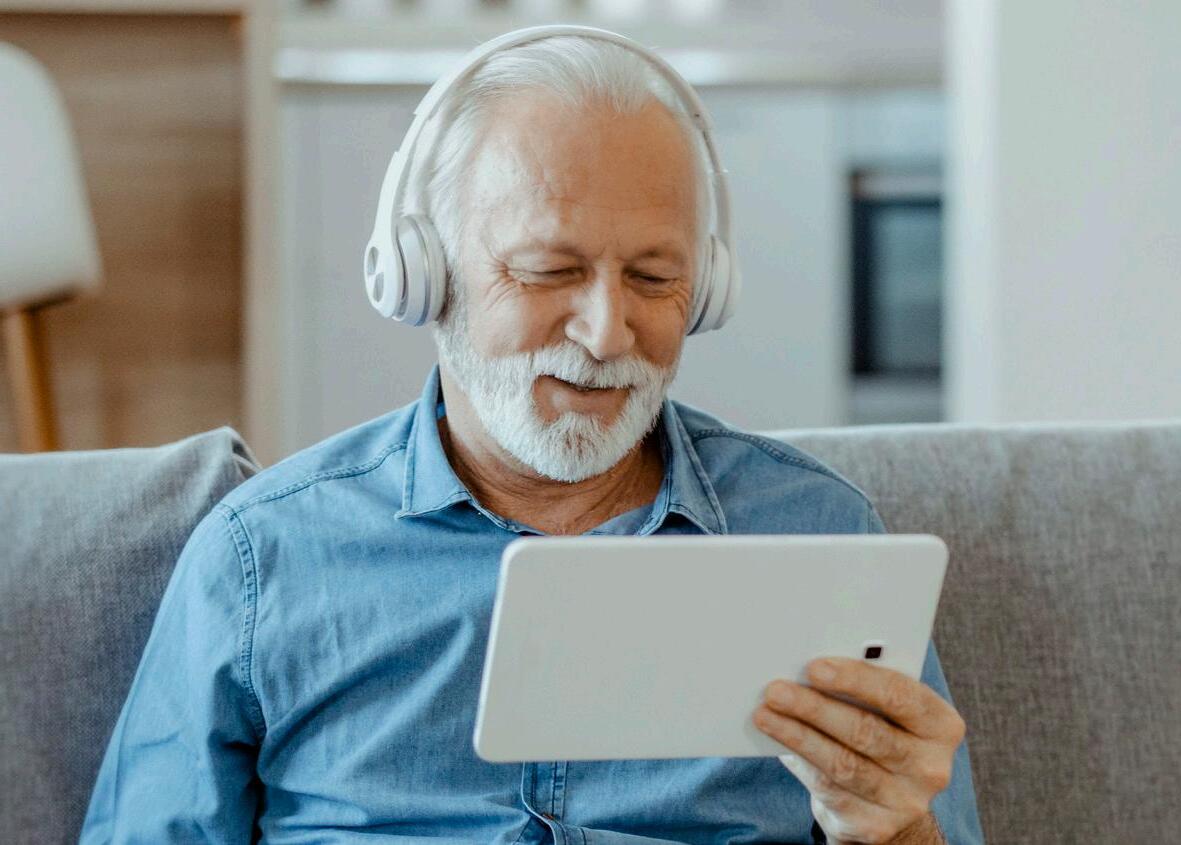
Game shows, a challenge for your ears!
Game shows with people yelling and loud background music are a real challenge in terms of listening and understanding, even for people who hear perfectly. So it’s important to have realistic expectations. Even if you have the best hearing aids on the market, this type of TV show will still be hard to understand.

08 © Lobe Guide 2024 / © Lobe Publications 2024
In the Car
According to people with hearing loss, communication in a car is one of the most difficult listening situations. There is a lot of noise in a car (e.g., engine noise, tires on the road, ventilation system, radio, wind noise, rain and wipers).
Those noises cover speech, both for people with hearing loss and people with good hearing. When a person with hearing loss is driving, they cannot easily rely on visual speech cues like lip movements, facial expressions or gestures to help with understanding, and can only rely on what they hear.
A study by Meston et al. has shown that car trips are a good opportunity for important or more personal conversations. Participants of the study with hearing loss reported feeling frustrated, embarrassed or left out when they were unable to understand a conversation while driving, hence the importance of using effective strategies for improving communication and making the driving experience more enjoyable.
For the person with hearing loss
Before leaving
• If passengers are not aware of your hearing difficulties, inform them.
• Check your route.
• Leave ahead of time to avoid the stress of being late.
• If you are driving with multiple passengers, ask the person you will be talking to the most to sit in front with you.
• If you are a passenger, sit beside the person you will be talking to the most.
In the car
• Wait for a stop or a red light to ask for details about the route.
• When you want to talk, reduce the noise and eliminate distractions.
- Turn down the ventilation system (air conditioning or heating) or turn it off.
- Turn down the radio or turn it off.
- Close the car windows.
• If you have hearing aids, use them.
- Ask your navigator to wear the microphone compatible with your hearing aids.
- Ask your navigator to use the microphone of your personal amplifier.
• If needed, park the car in a safe place to have a conversation.
For conversation partners
• If a person with hearing loss is driving and a situation arises where they need more concentration, avoid:
- non-essential conversations;
- making unnecessary noises.
• Talk a little more loudly, without yelling.
• Repeat what was misunderstood.
• Use short and simple sentences.
• If the person with hearing loss has an external microphone or a personal amplifier connected to their hearing aids, use it to facilitate communication.
When you give directions to a person with hearing loss
• Be as concise as you can.
• Take advantage of when the car is stopped to give directions, and give them a little ahead of time.
• Give visual indicators by pointing in the direction to go.
• If needed, suggest parking the car in a safe place to have a conversation.
09 © Lobe Guide 2024 / © Lobe Publications 2024
At the Restaurant
Restaurants present a particularly difficult listening challenge for people with hearing loss. They are very noisy environments because of all the people talking, the servers moving about, etc. Music and clattering dishes add to the racket.
Most of the time, we have no control over this type of situation, which can unfortunately make going out more stressful. This is why it is essential to use the communication strategies. It is also important not to hesitate to use hearing assistance systems to make the experience more enjoyable.
For the person with hearing loss
Picking the right restaurant
• Choose a restaurant where the tables and chairs are wood or upholstered, and where the floor covering is wood or carpet.
• Avoid, if you can, restaurants where there is too much echo (e.g., big dining room, high ceilings).
• Avoid sports bars, which are especially noisy.
• Avoid restaurants where tables are connected to each other.
• Avoid restaurants where the lighting is too dim.
• If possible, choose a restaurant that you know is quieter.
- Scout around to find restaurants that are less noisy in your community.
- Keep a list of quieter restaurants and those with quieter areas.
• Suggest that guests choose a restaurant you know is quiet.
• Suggest going out to eat during off-peak hours.
Once the restaurant has been chosen
• Many restaurants post their menu on their website. Become familiar with it beforehand.
• More and more restaurants offer the option of booking a table online. Look for the “Book a table” tab or icon. Otherwise, call the restaurant to book a table (or a private room if many of you are going).
Picking the right table


The best table for a person with hearing loss is:
- located in a secluded place (especially when tables are close together);
- placed along a wall or in a corner. This helps reduce noise, since a table in the middle of a room gets noise from all directions;
- located far from the kitchen doors, bar, entrance, buffet (if any), and speakers;
- well lit, so you can see the lips and facial expressions of your table partners.
© Lobe Guide 2024 / © Lobe Publications 2024 10

The lighting at your table
• If the lighting is insufficient, ask the server if it can be turned up.
• Move sources of light (candles, lanterns, small lamps) to the side of the table to avoid having them directly in your field of view.
Picking the right seat at the table
• If you're assigned a rectangular table, sit at the end of it so you can get an overview of the group.
• Sit with your back to the windows to avoid glare and backlighting.
• Sit where there is less of a chance that the server will stand behind you to speak to everyone.
• Sit so that the dining room noise comes from behind you.
• Sit near people who are comfortable repeating things to help you.
• If you go to a restaurant during the day, ask for a spot near the windows and sit with your back to them to avoid backlighting and ensure your partner’s face is well lit.
If you only wear one hearing aid
• Try to sit with your hearing-aid ear near the wall or window (unless the window opens onto a noisy street).
• Sit facing the people you will be talking to the most.
• If you hear better with one ear than the other, sit with your “good” ear next to the people you will be talking to.
Before the meal
• Tell your table partners that you have hearing problems and give them some example of what can help you.
During the meal
If you have hearing aids or other technological aids such as an external microphone, a personal amplifier or a personal FM system, use them.
If the background music is too loud, ask the server if it can be turned down.
If the server tells you the daily menu orally, ask for a printed version.
Ask your partners to look at you and not to cover their lips.
• If you get lost in a conversation, confirm the conversation topic or ask someone you get along well with to help you.
• Ask to be advised when there is a change in topic.
• Ask your partners to repeat what you did not understand.
• If you are a big group, break into subgroups of 2–3 people for discussions and change groups when needed.
• Ask specific questions. For example, instead of asking “What’s new?” say “How is work, how are your kids, how is home?”
• Verify your understanding during the conversation, for example, “So, if I understood correctly…” or “You are talking about…”
• Find and look at the person talking.
• Advise your partners if you think you’ll have more trouble following the conversation, e.g., “I’m tired today, so it’s harder for me to follow” or “It’s noisy here. I’m sorry, but I will have to ask you to repeat frequently.”
• If you did not understand, ask your partners to:
- speak more slowly and a little more loudly;
- repeat what you did not understand;
- say the sentence in other words;
- make short sentences.
Tips!
If you are with a group, opt for a round table so you can see each guest’s face.
Ask the server which table is the quietest at the restaurant, and ask if you can take it.
© Lobe Guide 2024 / © Lobe Publications 2024 11
For conversation partners
• Choose a restaurant that is not too noisy and avoid peak hours.
• Ask people with hearing loss what is the most strategic place for them to sit.
• If people with hearing loss have hearing aids, encourage them to use them.
• Do not speak while others are speaking.
• When you speak to people with hearing loss, look at them so they can read your lips.
• Advise people with hearing loss when there is a topic change in the conversation.
• Avoid making unnecessary noises during the conversation.
• If you see that people with hearing loss have not understood a message:
- repeat it once as you said it initially;
- if the person still does not understand, reformulate it;
- ask the person what part of the message they did not understand well.
Additional strategies for fast-food restaurants (e.g., McDonald's, Subway, Tim Hortons)
• Tell the cashier that you have hearing loss.
• Do not act like you understood if you did not.
• Make a specific order, e.g., “I’ll take one small black coffee with an apple turnover to go. That’s it. Thank you!”
• Look at the cash register screen to see the amount to pay.





12 © Lobe Guide 2024 / © Lobe Publications 2024
Waiting Room

For the person with hearing loss
Before leaving
• Bring paper and pen.
• Make sure your hearing aids are functional (e.g., batteries).
Once there
• If you have hearing aids, use them.
• Tell the receptionist that you have hearing loss.
• Ask that someone come directly to tell you when it is your turn.

• Do not act like you understood if you did not.
• Ask the receptionist to use the basic communication strategies (see section Basic communication strategies).
• If needed, ask someone to write down important information.
• Ask that someone write in your medical file that you have hearing loss.
• Ask people to use gestures to support what they are saying (e.g., point where you have to go, show the room number with their fingers or write it down).

• If you have a cellphone, ask when you check in if text alert service is available. If so, ask to be registered for it so you will receive a text notification of your place on the waiting list.
• For places with a number calling system, sit somewhere you can easily see the numbers and hear the sound signal.
Basic communication strategies
Ask your partner to...
• look at you and not cover their face;
• talk more slowly and a little more loudly, without yelling;
• make short and simple sentences;
• write down important information.
© Lobe Guide 2024 / © Lobe Publications 2024 13
At the Doctor's
For the person with hearing loss
Before your appointment with the doctor
• Make a written list of what you want to talk about.
• Bring paper and pen.
• Make sure your hearing aids are functional (e.g., batteries).
In the waiting room
• If you have hearing aids, use them.
• Tell the receptionist that you have hearing loss.
• Ask that someone write in your medical file that you have hearing loss.
• Ask the receptionist to use the basic communication strategies (see section Basic communication strategies).
• If needed, ask the receptionist to write down important information.
During the appointment
• Be positive and relaxed.
• If you have hearing aids, use them.
• Remind your doctor that you have hearing loss.
• Do not act like you understood if you did not.
• If there is something you did not understand, ask your doctor to repeat it.
• Tell your doctor how to help you: look at you and not cover their face, talk more slowly and a little more loudly, make short and simple sentences.
• Observe the doctor when they are talking to you (lip movements, facial expressions).
• Ask the doctor to write down important things you discussed during the appointment.
• If you feel like you are not able to understand everything, ask another person to go with you.


If you have to take off your hearing aids during the appointment
• Inform the doctor that you do not hear well without your hearing aids.
• Before taking your hearing aids off, ask the doctor to explain what will be done.
• After the exam, put your hearing aids back on and ask your doctor to explain the important things (e.g., observations).
At the end of the appointment
• Repeat what you understood to be sure you got all the important items.
• If you need to make another appointment, do it on the spot if possible (not on the phone).
14 © Lobe Guide 2024 / © Lobe Publications 2024
At the Dentist's
For the person with hearing loss
Before leaving
• Bring paper and pen.
• Make sure your hearing aids are functional (e.g., batteries).
In the waiting room of the dentist's office
• If you have hearing aids, use them.
• Tell the receptionist that you have hearing loss.
• Ask that someone write in your medical file that you have hearing loss.
• Ask the staff to use the basic communication strategies (see section Basic communication strategies).
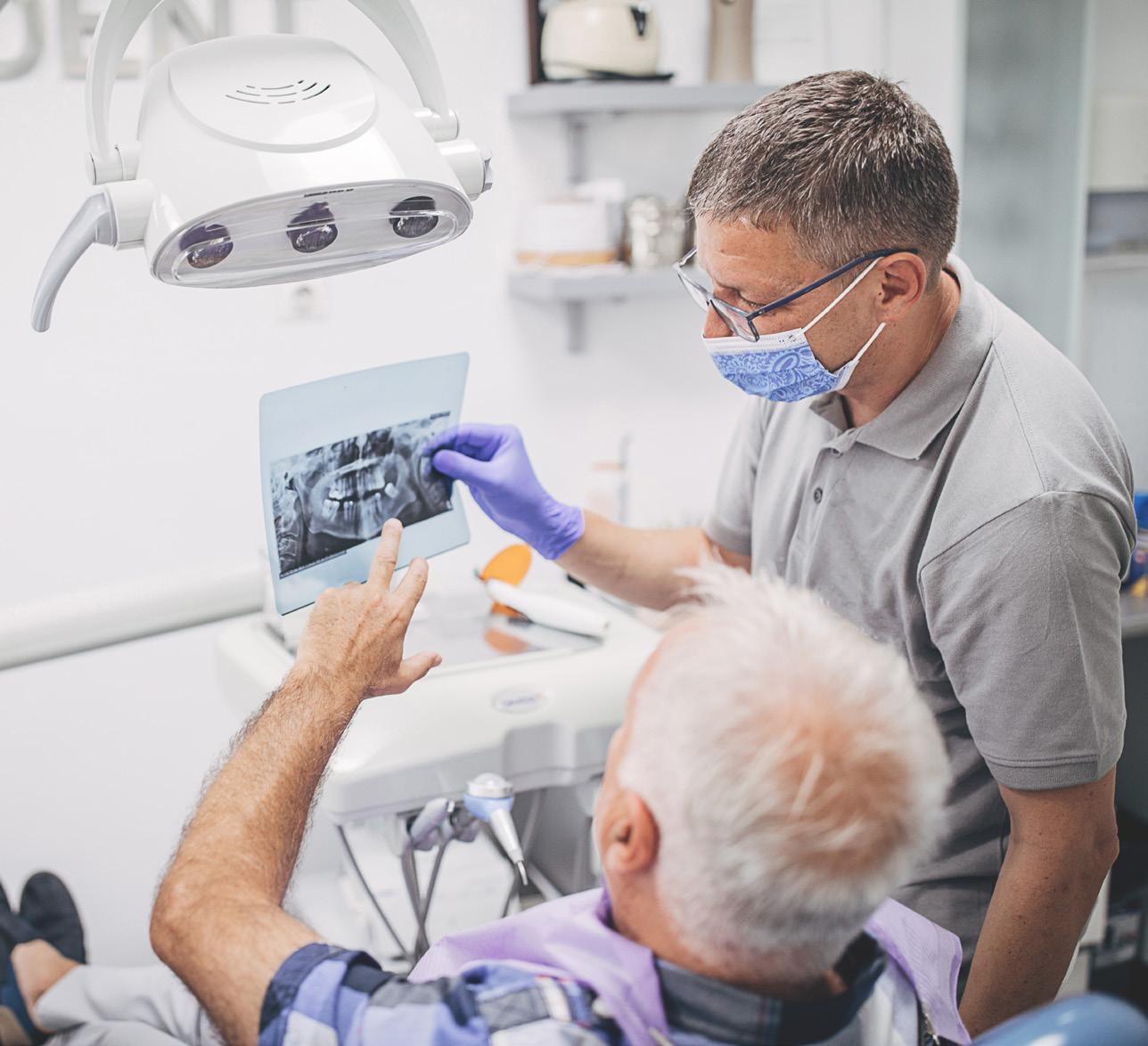


• If needed, ask someone to write down important information.
In the examination room
• Advise the dentist and the dental hygienist that you have hearing loss.
• Ask them to use the basic communication strategies (see section Basic communication strategies).
• During the examination, when a member of the staff wants to talk to you, ask them to:
- turn off any noisy tools that are on;
- put your chair in an upright position so you can see their face;
- remove their mask so you can see lip movements and facial expressions.
• If you have to remove your hearing aids (e.g., for x-rays), ask about the procedure before removing them.
Basic communication strategies
Ask your communication partner to...
• look at you and not cover their face;
• talk more slowly and a little more loudly, without yelling;
• make short and simple sentences;
• write down important information.
15 © Lobe Guide 2024 / © Lobe Publications 2024
Conferences in Public Places
For the person with hearing loss
Before the conference
• Ask if the establishment has a communication system for people with hearing loss.
• See the lecturer to:
- make them aware that you have hearing loss;
- ask them to use the microphone of the communication system provided by the auditorium or your personal system (e.g., MF, infrared);
- ask them not to speak too quickly during the presentation;
- ask them to repeat other people’s questions and comments, if needed;
- ask them to control turns to speak;
- discuss lighting (to be sure it is adequate).
Did you know?
Many technologies improve the listening experience during conferences in public places.
Consult your hearing health professional for more details.
• Arrive early to choose a seat:
- with a good view of the lecturer;
- near the speakers.
• If you hear better with one ear than the other, sit with your “good” ear facing the speaker or lecturer.
• Make sure your hearing aids are functional (e.g., batteries).
• Bring paper and pen.
• If a printed conference program is available, take one.
During the conference
• If you have hearing aids, use them.
• If you brought someone, ask them to take notes during the conference.
For those accompanying the person with hearing loss
• Take notes during the conference to share them with the person with hearing loss.

Repeat questions and comments of other people at the conference, if needed.

© Lobe Guide 2024 / © Lobe Publications 2024 16
Theater
For the person with hearing loss
When choosing the theatre and the show you want to see
• Consult the online directory of adapted theatres to see if the place is equipped for people with hearing loss (www.auditionquebec.org/repertoire).
• If the place you want to go is not in the directory, ask the establishment directly.
When buying a ticket
• Inform the cashier that you have hearing loss.
• Ask them to look at you when they talk.


Ask to have access to services for people with hearing loss, where applicable, and ask if there are seats reserved for people with hearing loss.
Get printed materials, if available. For example, ask for the show program.
If there's a place that interests you and has no services for people with hearing loss, don't hesitate to call the direction and ask.
At the end, confirm that what you heard was right.
In the theatre
Use the theatre’s device for people with hearing loss, if applicable.

If you weren’t able to reserve in advance, try to arrive a little early so you can choose the best seats.
Which seats should I choose?
The best place for you is in the centre of the theatre, near the speakers, and in a row where you can see the entire stage.
Another option would be a side-facing seat, with your “better ear” facing the stage or speakers, as the case may be.
17 © Lobe Guide 2024 / © Lobe Publications 2024
Home Phone
For the person with hearing loss
Before making your call
• If you have hearing aids, make sure they are functional (e.g., batteries).
When you want to make a call
• In general, remember to use your better ear on the phone.
• Make a list of answers to the questions that could be asked, or of the questions you want to ask.
• For example, when making an appointment, the receptionist could ask you:
- the reason for the appointment;
- the days and times of day you are available;
- the time you would like your appointment;
- if the suggested timeframe is okay with you.
• Choose a time of day when you're rested and calm to make your phone calls.
• Eliminate or reduce surrounding noise.
- Turn the radio or television down, or turn them off.
- Make sure your dishwasher is not on.
- Go to a quiet room and close the door.
- Reduce or eliminate distractions. Per example, when you answer the phone, stop what you are doing (crosswords, knitting, television, cooking).
When you receive a call
• If you have a phone display, look at the number of the person calling to help you prepare for the conversation.
• If you have hearing aids, use them.
• For other tips for using your hearing aids on the phone, ask your audioprosthetist.
• If you have assistive listening devices, use them (e.g., amplified phone, portable phone amplifier, Bluetooth adapter).
• If the person at the other end does not know you, tell them you have difficulty hearing.
• Verify if you understood by repeating the information you heard.
If you did no quite understand…
• Make sure you know the topic of the conversation.
• Make sure you know who you are talking to.
• Say in your own words what you understood.
• Ask specific questions that lead to closed answers (yes or no). You can also identify a limited number of choices to better anticipate the answer.
• Ask your partner:
- to repeat the message more slowly;
- to reformulate what they said;
- to use simpler and shorter sentences;
- to pause between each sentence so you can verify what you understood.
Tips to understand the names of people and places
Ask your conversation partner…
• To repeat more slowly and pause between each word.
• To slowly spell the word you didn’t understand.
• To use reference words or categories to verify if what you understood is right: “Summer Street, like the season?” or “Rose Street, like the flower?”
• To give clues to help you find the word: “Is it the name of a woman/man/street/city?”
18 © Lobe Guide 2024 / © Lobe Publications 2024
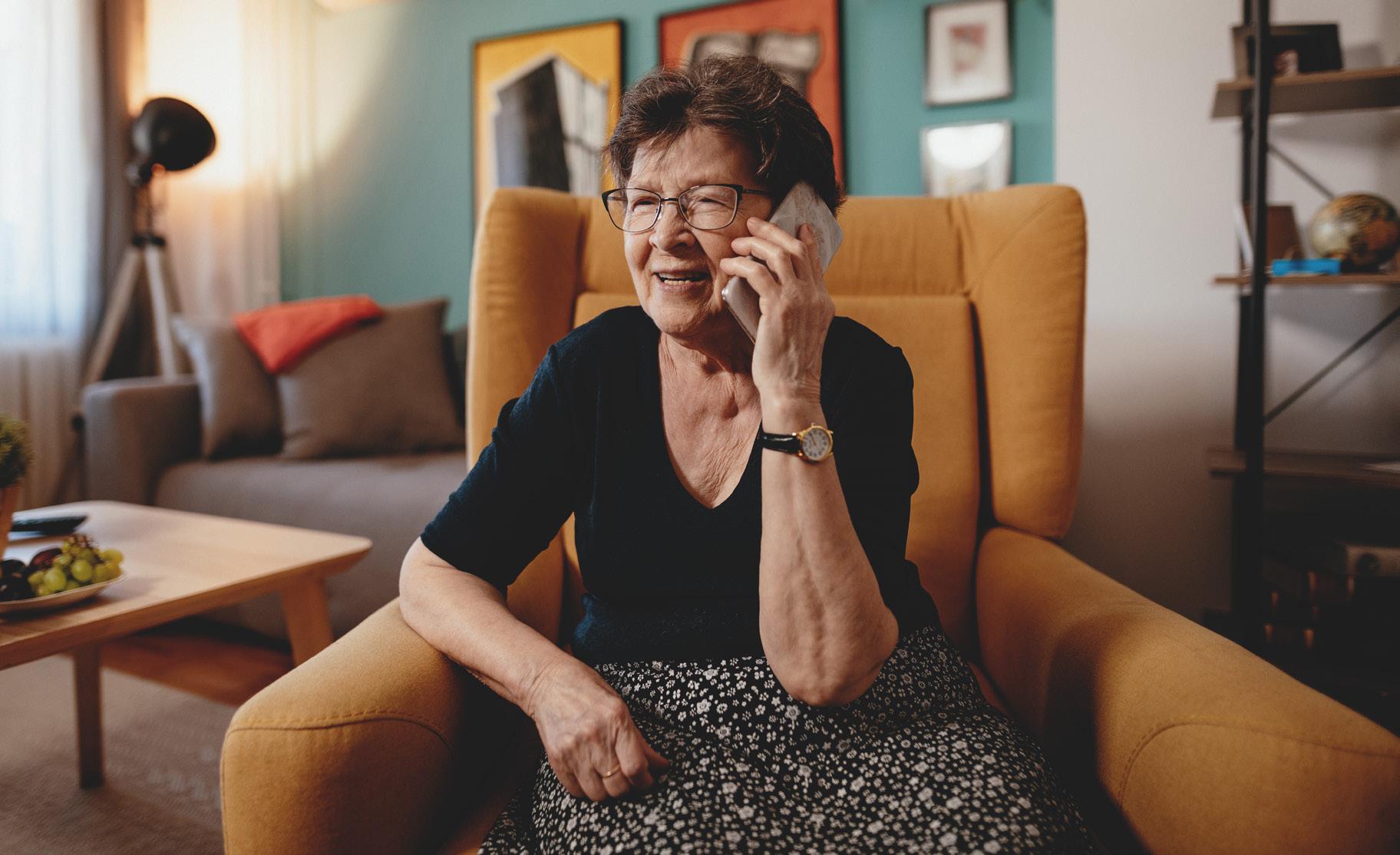
Tips to understand numbers
Ask your conversation partner…
• to repeat numbers more slowly and to say each number separately. For example, for 70 (seventy): 7 (seven), 0 (zero);
• to say the number that comes before or after: “Is it 6, number after 5?”;
• to count and to stop when the person has the right number.
For afternoon times
• Verify by giving two possibilities: “It is at one o’clock a.m. or p.m.?”
• If needed, ask people to communicate with you by email or text messages.
At the end of the conversation
• Always validate important items by pausing between each piece of information: “If I understood correctly, I have an appointment Tuesday, June 23 (pause) at 10 a.m. (pause) with Dr. Martel?”
• Thank the person for helping you understand better.
General tips
• Stay calm and positive.
• Persevere even if it is hard.
• Be assertive.
• Do not act like you understood if you did not. If you have any doubts about what you understood, change your communication strategy.
For conversation partners
• When you give instructions (e.g., meeting time and place), make sure people with hearing loss have understood by asking them to repeat the important items.
• Answer their questions.
• Eliminate or reduce the surrounding noise, if any, e.g., turn off the TV or radio.
• Do not yell. Yelling changes the tonality of the voice and makes it harder to understand.
• Talk more slowly and articulate each word.
• If people with hearing loss do not understand well or ask you to repeat a sentence, do so. If they still don’t understand, say it in other words.
- Sentence not understood: “We will see each other for supper at 6 o’clock, January 12.”
- After modification: “You are coming at my place at 6 p.m. in the evening, January 12.”
• Spell out words or say numbers one by one, if needed:
“I’m talking about Guylaine, G-U-Y-L-A-I-N-E.”
19 © Lobe Guide 2024 / © Lobe Publications 2024
Assistive Listening Devices

Many health facilities provide assistive listening devices for people with hearing loss (e.g., personal amplifiers, telephones with built-in amplification and television listening systems).
Personal amplifiers
As their name implies, these devices amplify sound and transmit it directly to your ears. They are similar to a portable radio. Models may vary from one establishment to another.
Personal amplifiers can be useful if you do not have hearing aids or if you cannot use them. Simply ask.

Telephones with built-in amplification
These telephones are specially designed for people with hearing loss. They amplify voices and ring tones, and let you control volume and tonality for comfortable, customized listening. The telephone receiver is often compatible with “T” position hearing aids (telecoil).
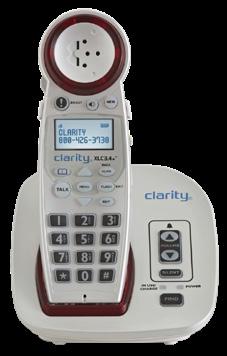
Television listening systems
These devices let you choose the television volume you want without disturbing other people in the room. A wireless microphone installed near the television picks up sound and transmits it to a receiver worn around the neck. The receiver lets you adjust the sound as you wish, without changing the sound coming from the television.
Did you know?
There are a lot of assistive devices to help you hear the phone ringing or your partner’s voice. Some systems are compatible with hearing aids, others are not.
For more information about these devices, where you can buy them or how they work, consult your hearing health professional.
20 © Lobe Guide 2024 / © Lobe Publications 2024
9
Calling 9-1-1 (emergency services)
For people with a hearing loss
1 Dial 9-1-1 on your phone and wait a few seconds.
2
3
4
Texting 9-1-1
What is 9-1-1 texting services?
This free service lets calling services and centres send you text messages. You can also use it to communicate with emergency services. It is designed especially for people who are deaf, have hearing loss or have a speech disorder.
How can I access it?
You must be a T9-1-1 service subscriber and call 9-1-1 in order to subsequently communicate with emergency services by text messages. Texting 9-1-1 from a non-registered cellphone will not work. Texting 9-1-1 without first calling 9-1-1 will not work either.
To subscribe to T9-1-1 service, contact your mobile phone service provider.
5
Say your name: “My name is…”
Say you have a hearing loss:
“I have a hearing loss. I cannot understand your questions on the phone.”
Give your address or describe where you are:
“I’m live at...”
“I’m at the corner of Watt Avenue and 2nd Street.”
Explain how you’re feeling or what’s happening:
“I don’t feel well because…”
“My house is on fire.”
“There was a car accident.”
Once registered, how do I use the service?
When you want to use the 9-1-1 service:
1
2
3
Dial 9-1-1 from your cellphone.
The 9-1-1 operator receives a request to communi cate with you by text message.
You do not have to talk.
The operator communicates with you by text about the emergency situation.
For full details, go to https://www.textwith911.ca/en/how-to-makea-t9-1-1-call/
Tips for using the service
• Send short and specific message.
• To avoid confusion, avoid abbreviations.
• Only use the service for emergency situations requiring police, firefighter or ambulance response.
- 1 - 1 21 © Lobe Guide 2024 / © Lobe Publications 2024
Hearing Health and Communication Professionals
The mission of the professionals practicing within the Lobe clinics is to make a difference in people's lives. They do this through a multidisciplinary, patient-centred approach and by providing people with hearing, language and speech disorders with the necessary resources to improve their quality of life.
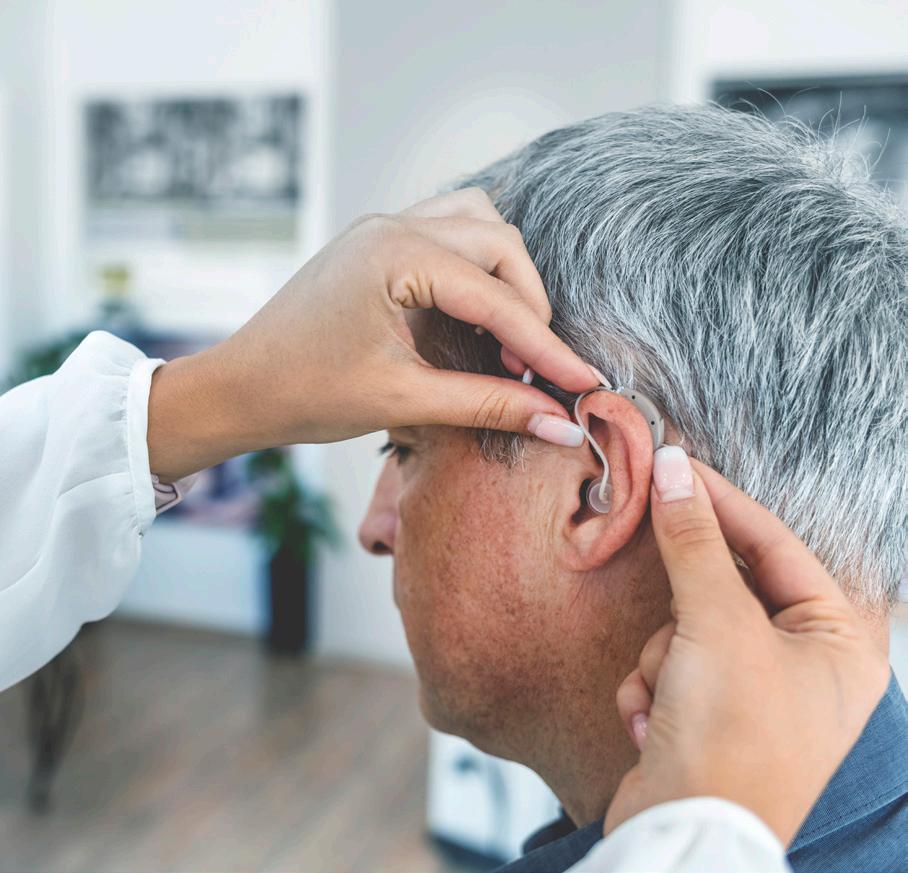

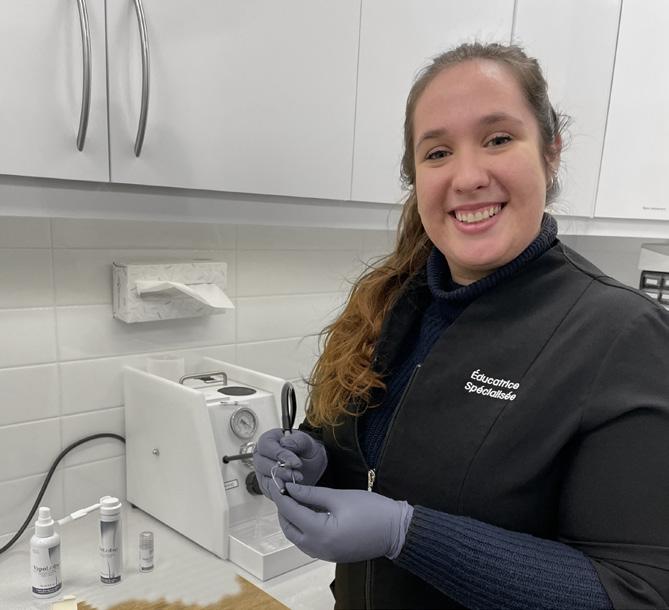
ENT specialist (ear-nose-throat specialist)
Treats illnesses of the head and neck (ears, nose and throat). The services of ENT specialists are reimbursed by RAMQ.
Audiologist
Evaluates hearing (hearing test) and central auditory processing disorder (CAPD). Their services can be reimbursed by CNESST, Veterans Affairs Canada and most private insurance plans.
All recommendations from health professionals are accepted. No medical references are necessary.
Audioprosthesist
Helps patients with hearing loss select hearing aids and assistive listening devices, and makes required adjustments during fitting. Their services can be reimbursed by RAMQ, CNESST, Veterans Affairs Canada and most private insurance plans.
Specialized educator
Working with an audioprosthetist, educates patients with hearing loss on their hearing aids and offers hearing re-education. The services of specialized educators are free of charge*.
An assessment by an audioprosthetist is required to determine which hearing aid suits the patient’s needs.
*Permanent offer. 18 and over.
© Lobe Guide 2024 / © Lobe Publications 2024 22
80% of people with hearing loss aren't diagnosed or receiving proper care.*
*Ordre des audioprothésistes du Québec
This statistic clearly shows the need to make people aware of the importance of maintaining good hearing health and point them toward a hearing health professional when they have questions about their hearing.
This led to the idea of publishing Lobe Magazine, an informative magazine distributed for free throughout Quebec, in French and in English.
Lobe Magazine features articles by hearing health and communication professionals working within the Lobe clinic network. Each article is meant to inform people with hearing loss and the public in general of the various issues tied to hearing, language and communication. Our ambassador, Marie-Josée Taillefer, also writes a column in every issue of the magazine.
Lobe Magazine offers readers accurate, relevant information that we hope will help them improve their lives and break the isolation caused by hearing loss.
ways to get Lobe Magazine:
1 Online, free of charge, on the Customer Account of boutique lobe.ca/en. Available just a few days before its release.
2 Print subscription for 3 issues per year. Available on boutique.lobe.ca/en. Some conditions apply.
3 Free of charge, in all Lobe clinics and at our different partners. Lobe Magazine, the reference in hearing health! Subscribe Now! Questions
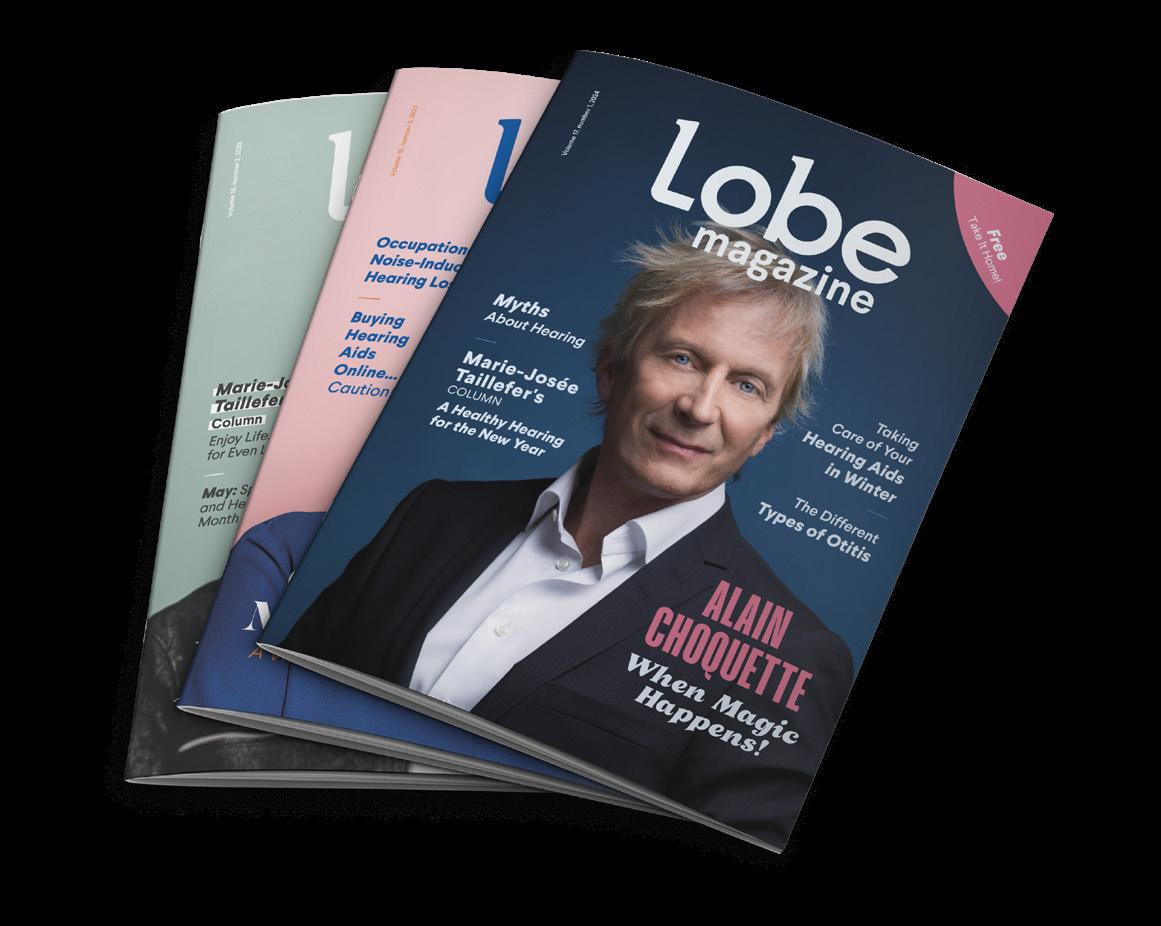
or comments? Email us : info@lobe.ca
© Lobe Guide 2024 / © Lobe Publications 2024 23
Hearing health speaks to everyone.
To learn everything about hearing health, get the latest edition of Lobe Magazine and subscribe to our newsletter.
 Marie-Josée Taillefer Ambassador of Lobe Clinics and Hearing Health
Marie-Josée Taillefer Ambassador of Lobe Clinics and Hearing Health
1 866 411-5623 / lobe.ca
us on Social Media
Follow
© Lobe Guide 2024 / © Lobe Publications 2024
 Taillefer Ambassador of Lobe clinics and hearing health
Marie-Josée
Taillefer Ambassador of Lobe clinics and hearing health
Marie-Josée










































 Marie-Josée Taillefer Ambassador of Lobe Clinics and Hearing Health
Marie-Josée Taillefer Ambassador of Lobe Clinics and Hearing Health